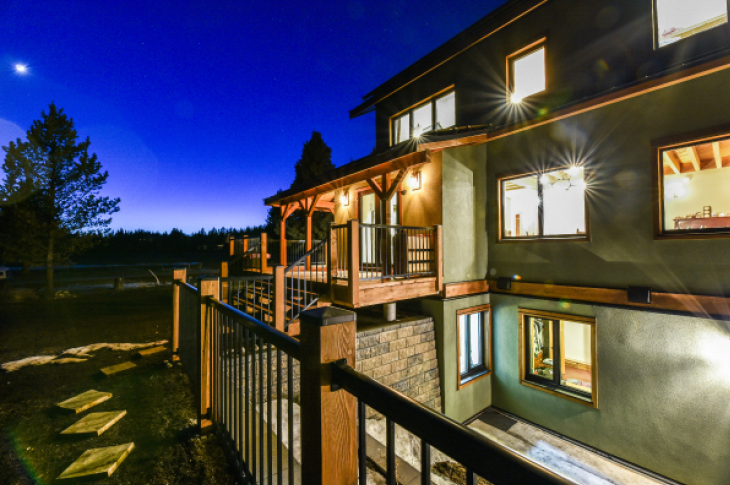SAIT team talks tech and the paradigm shift to sustainable home building

digiTALKS
A dialogue on the evolution of technology and the impact digital transformation is having on business, industry and careers
Last week, team members from SAIT’s Living Building Challenge (LBC) project hosted a discussion on some of the technology innovations that helped bring “The Confluence” to life.
If you missed this latest digiTALKS dialogue, learn a little about the obstacles, opportunities and lessons learned during the project, then take a tour of the house that green technology built.
What were some of the most challenging obstacles of this project?
Tracey Chala, Principal Investigator, Green Building Technologies
The materials guidelines, or petal, of the LBC has been very hard for our team — for everybody from suppliers, trades and manufacturers.
We researched more than 800 products, and you’re vetting each one against the “red list.” You're looking at the ingredient composition, volatile organic compounds (VOC) content and emissions, where it’s coming from and what kind of footprint the product has because you’re trying to source your products from a small radius of the project site. Imagine how big our excel spreadsheet is — the materials piece is a lot.
Hayley Puppato, Project Coordinator, Green Building Technologies
With the landscape plan, we faced a lot of challenges in addressing the requirements for the LBC urban agriculture imperative of 25% of the project area as useful agricultural area.
This is especially difficult in a northern climate, plus there are other challenges to the location, including wildlife. We looked at many different agriculture strategies, at food forests and non-traditional agriculture — a three-season green house will be built with lots of technology components.
Ultimately, we were granted a small exception from the International Living Future Institute because of those challenges.
Where do you think the future of sustainable home building is headed?
Rob Avis, Principal Investigator, Green Building Technologies
I see the LBC and this project as a paradigm shift. Buildings, the way they’re currently built, basically rob from us.
This building represents a new paradigm — everything about it gives back to you. It improves your health, grows your food and harvests its own energy. While this building is more expensive than a conventional build, once the paradigm shifts and people start demanding the largest investment we make in our lifetime not rob from us anymore, then our homes will shelter, feed and power us.
That’s why this was so hard. This is why Green Building Technologies (GBT) exists. We help take the bleeding edge off of the bleeding edge for companies that want to innovate.
Tracey Chala, Principal Investigator, Green Building Technologies
We’ve had a lot of questions about cost — how much more is this house than my house?
The other buildings on the LBC list were in the several million dollar range. The range for this building is between 500K and one million.
Green building features do still come at a premium at this time. But the building code is going to be changing and public support for projects like this is only growing. I feel like these sustainable builds are going to be common place and that premium for green features is going to go out the window.
How will technology continue to enhance the paradigm shift toward sustainable building?
Tyler Willson, Principal Investigator, Green Building Technologies
We’ve all seen the rise in smart building technologies aimed at consumers. There is a parallel development going on in the commercial and industrial sectors. To really grasp the impact of these developments and make decisions on them, we need strong monitoring and data strategies to accompany them.
We can see examples of industry developing this way, when we look at utility company adoption into smart meters.
On the consumer side, we know by showing people how much energy and water they use, they’re going to reduce their consumption. We see homeowners with dashboards on their phones but that will move into the home, like your Nest thermostat.
All this data brought into useful forms is the catalyst for recipes in energy reduction. The data professional is going to see themselves in a lot more industry scenarios than they expected.
How can others tap into the brain trust developed during this project?
Melanie Ross, Research Associate, Green Building Technologies
At GBT we’re always looking at ways to take the lessons learned from one project and apply them to the next. LBC has brought together all of our GBT focus areas under one project — ultimately our goal in building is to have all of these focus areas work together.
We're looking at leveraging what we've learned and how to share that knowledge with industry. The "red list" research also led to us doing a lot of advocacy with manufacturers who didn’t have products we could use.
Also the work on the dashboard, data gathering and analysis is another key area for GBT to incorporate into other builds.
All of these elements have been done with different partners and we’ll be using all this work as stepping stones to inform future projects.
Plug into digiTALKS
Stay up-to-date with emerging technology trends impacting all sectors of our economy.
📅 Leading cyber security in higher ed: Mitigating vulnerabilities in an interconnected worldTuesday, April 6
Industry Driven
We prepare students for successful careers and lives.
SAIT'S
2020-2025
Strategic plan

Oki, Âba wathtech, Danit'ada, Tawnshi, Hello.
SAIT is located on the traditional territories of the Niitsitapi (Blackfoot) and the people of Treaty 7 which includes the Siksika, the Piikani, the Kainai, the Tsuut’ina and the Îyârhe Nakoda of Bearspaw, Chiniki and Goodstoney.
We are situated in an area the Blackfoot tribes traditionally called Moh’kinsstis, where the Bow River meets the Elbow River. We now call it the city of Calgary, which is also home to the Métis Nation of Alberta.
